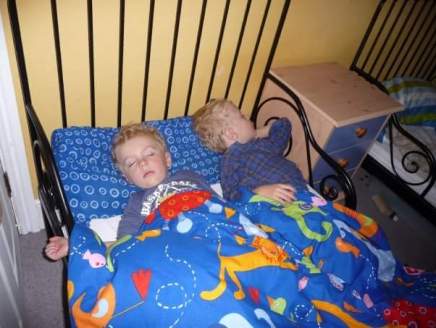Babies and toddlers wake in the night. We know that. Babies and toddlers often like to feed a lot in the night. That’s a given. But sometimes it all becomes too much. Sometimes its exhaustion, sometimes its nursing aversion, sometimes work commitments and sometimes it’s just that mum has had enough. Night weaning is generally not recommended until after 18 months by most Gentle Parenting experts. At this age they have some understanding of what is going on. Sleep is a developmental stage, like walking and talking, and babies and toddlers will do it when they are ready. Some will have large chunks of sleep from an early age and that’s fine, but others continue to wake frequently well into their second year. There are definite genetic factors at play.
Breastfeeding is by far the easiest and fastest way to settle a baby back to sleep when they wake. But there may be a point where mum needs to stop it. This should be for the mum to decide and nobody else. She will know if she is ready to night wean. If she is not sure whether she should, then it probably is not the right time yet. It is nobody else’s decision; not the health visitor, grandmother or even the partner. And just to make sure you understand, night weaning will not necessarily make them sleep any better. They may still wake, and you will have lost the easiest way to get them back to sleep. However with lots of consistent alternative reassurance they will begin to be able to transition from one sleep state to another. Toddlers not being too over tired during the day will also help with this.
Breastfeeding at night is not so much about nutrition for toddlers. There is a big emotional context to it. Breastfeeding is helping them feel safe, to deal with all the big emotions of being a toddler, to deal with the pain of teething, to reconnect after being separated due to work and child care. There’s a whole load of stuff going on. So it’s important not to take away the other comforts that they are used to whilst you try to night wean. Co-sleeping, bed-sharing, cuddles, using a comforter like a toy. These can help the transition away from relying on the breast to settle back to sleep.
Find other ways to settle your toddler at night. There are many different things you can try as a replacement for breastfeeding; cuddling, stroking, patting, singing, use of a special toy or blanket, music, white noise, whatever works best for you. Some will work better than others and everyone is different. You will find the best option for your family.
One thing to try is to cuddle or stroke back to sleep whilst they’re stirring before properly awake. Toddlers go through sleep cycles from deep, slow wave, sleep to light REM (rapid eye movement) sleep regularly and it is during the REM sleep that they often fully rouse and need help to resettle back into a deeper sleep again. Unfortunately a toddler’s sleep cycle is much shorter than an adult’s. This only really works if you are bed sharing as you will need to be in close proximity to be aware when they are about to wake. But if you can cuddle or rest your hand on their body and settle before they are completely awake, you may find they go back into another deep sleep without fully waking and demanding to be fed. I found turning my toddler away from me and cuddling tightly from behind worked fairly well.
Try with just one of the night feeds. Try the first wake-up of the night and see if you can settle your toddler in a different way. This is the most likely night feed to be able to drop more easily. As the night progresses and morning approaches, sleep often becomes lighter and toddlers are more difficult to settle back to sleep. They often like to get up very early at this age. The most likely thing to help you stay in bed for a bit longer is to continue to breastfeed in the early mornings!

Find another comforter. Toddlers often like to have a comforter in bed and these can really help to transition away from breastfeeding being the major comfort. The comforter can be anything your toddler is attached to. It can be a toy or blanket, or sometimes physical touch can replace breastfeeding; my toddler would slide his hand up my sleeve for comfort. The replacement comforter should be introduced well before the night weaning process is begun as it should not be seen as a replacement for breastfeeding but a separate comfort. Then slowly you can encourage your toddlers to become more dependent on this and less dependent on breastfeeding.
Shortening feeds. This can be especially effective if you are experiencing nursing aversion. Nursing aversion is a negative feeling some mums get when feeding. It is often hormonally driven, ovulation and menstruation can be a trigger, and pregnancy is a major culprit. So in order to continue being able to breastfeed, shortening the feeds can work well. You can talk to your toddler about having “a little bit”. To start with, tackle the bed time feed, pull off the breast by sticking in your little finger and breaking the seal just before your toddler is about to drift off to sleep and encourage them to do that last bit on their own. You can always re-latch them if it doesn’t work. Once the toddler is used to this you can gradually unlatch sooner and eventually they may settle to sleep from awake on their own. Some mums like to sing a song during this feed and when the song is finished, the feed is finished. If you are having a particularly bad day you can sing faster! Once they are good at settling to sleep without the breast they may be more able to move between their night time sleep cycles without feeding. They may settle for the song. Or they may settle with just a few of sucks.
Talk to your toddler throughout the day about how boobies will be asleep tonight and how they can have some in the morning. Let your toddler choose which comforter they would like to use. Remind them again just before bed time. Try to keep it positive. When will they be able to feed again, you can feed once the sun shines, boobies have gone to bed and will be back in the morning. Try not to focus on rejection; on saying no, not now. Some parents find a Gro-clock can be a great visual aide for this method. The Gro-clock can be set to go from day to night at a certain time and you can explain to your toddler that they can breastfeed once the clock says it is morning. You can set an early time to begin with and extend it later on, once they get the concept. There is also a lovely book called “Nursies When The Sun Shines” by Katherine C Havener which focusses on night weaning and explains to the toddler that she will be able to nurse when the sun comes up.

If your toddler is happy to settle with your partner, and they must be truly happy, sometimes this can be a good technique to night wean. Your partner can go in first and try settling first. If it doesn’t work then you can go in and breastfeed back to sleep. Some babies are more receptive to this than others. But often only the breastfeeding parent will do and if this is causing further distress it may be a good idea to stop. Remember for a toddler breastfeeding is a way to connect with you, their mum. So keeping the connection is important. We don’t really want to remove the mother completely from the comforting, just the breasts
Night weaning is often a very gradual process. Aim for small goals and baby steps. And don’t be afraid to stop if it does not feel right. Teething, illness, changes of circumstances, can all increase night waking and sometimes it may just be easier to go back to breastfeeding in the night again. Then once the unsettled period has passed you can try again. Also don’t be afraid to stop at a certain stage if you are all happy. Sometimes mums find that one or two night feeds are actually quite doable and continuing with these can actually make night times easier. Each journey is very personal between mum and her toddlers and what will work for one family will not necessarily work for another.
www.parentingscience.com/baby-sleep-patterns.html
www.feedsleepbond.com/how-to-stop-breastfeeding/
“The No-Cry Sleep Solution”; Elizabeth Pantley
“The Gentle Sleep Book”; Sarah Ockwell-Smith
Kathryn Stagg, IBCLC and ABM Breastfeeding Counsellor, Dec 2017

This is a great article, Kath!
This is such a lovely article with genuine gentle techniques. I am hesitant to read advise incase its sleep training in disguise but this was lovely and helpful!
This is such an amazing article.
Hi, any advice for where the toddler is saying they are hungry around 2am when night weaning? OK to give them food??